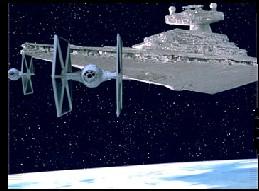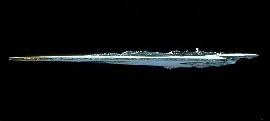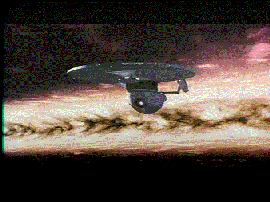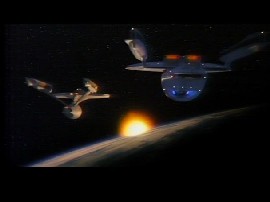| NapNuts Singapore Wargamers |  |
 |
||||||||||||||||||||||||
|
|
Introduction Welcome
to Captain arjun's Starship Combat Rules, where you command one or
more starships in fast-and-furious tactical space combat. Your Ship Each
ship is represented by a tabletop model and a Structural Display Chart
(SDC). The SDC shows the name and class of the ship, and the following
information: Power This
represents the energy generator of the ship. Each box in the Power
display produces one point of energy per turn. Energy is used for
movement and activation of Weapons system. Primary Weapons These are
the main armaments of your ship, and may be either energy or
projectile weapons. Each weapon will have a stated arc of fire. It
costs 2 points of Energy to activate a Primary Weapon. Secondary Weapons These are
the weapons meant for close-range work and defence against fighters
and missiles, and may be either energy or projectile weapons. Each
weapon will have a stated arc of fire. It costs 1 point of Energy to
activate a Secondary Weapon. Repairs The Repairs
boxes allow you to repair your Weapons and Shields when they are
damaged. Each Repairs box costs 2 points of Energy to activate. Shields These are
energy fields which absorb damage from weapons and protect your ship
from structural damage. There are six shields on your ship, one for
each facing. Each point of damage caused to your ship will delete one
box from the relevant facing shield. One a shield is completely
knocked down (i.e. all boxes deleted), damage inflicted through that
facing is applied to the ship's structures. Shields may be repaired. Hull These
represent the structural elements of the ship. The larger the number
of Hull boxes, the hardier the ship. Speed Mode The Speed
Mode of the ship is the number of points of Energy it costs to produce
one point of Speed per turn. Turn Mode The Turn
Mode indicates the manoeuverability of the Ship. A ship with
a Turn Mode of A may turn up to 60 degrees at the beginning and again
at the end of its movement. A ship with
a Turn Mode of B may turn up to 60 degrees at the beginning or the end
of its movement. A ship with
a Turn Mode of C may turn up to 60 degrees at the beginning of its
movement. A missile
has no Turn Mode, and may turn freely during its movement. Special Turn Sequence There
are 5 phases in each Turn:
Allocate energy Count the
number of intact Power boxes you have - this is the number of points
of Energy you have for the Turn. You must decide how to allocate these
to Movement and your Weapons, subject to the Speed limitations
explained later. If you do not allocate Energy to a system, it will be
inactive for the entire Turn. Unallocated Energy may not be stored and
carried over to a later Turn, and is forfeited. Essential
functions like Shields, Life-support and Communications are assumed to
be powered and do not need Energy to be allocated to them to work.
|
Declare
Speed Once all
players have completed their energy allocation, they declare the Speed
at which their ships are moving this Turn. The Speed represents the
number of inches the ship MUST move this Turn. The maximum
Speed for any ship is 12. Note that
you may not increase or decrease the Speed of your ship by more than
100% per Turn, except a stationary ship may increase its Speed to up
to 4 in one Turn. If you have insufficient Energy to keep the Speed to
the requirement, all energy must be allocated to Speed that Turn. Movement Movement is
not simultaneous. Players take turns moving their ships, in the
following order:
Where there
is more than one ship of that Turn Mode, move the faster ship first. Firing Firing
occurs simultaneously. Each player declares which Weapon/ he is firing
and its target. When all declarations have been made, measure the
range for each ship to its target in inches, rounding up all
fractions, and determine the damage caused as follows:
If you roll
2 or more '1's when firing a Primary Weapon, the Weapon is jammed and
causes no damage that Turn. The Weapon may not be activated again
until a successful Repair roll is made. Damage
caused is deducted from the Shield facing the attacking ship. Delete
one box on the Shield for every point of damage scored. Any damage
scored through a 'down' shield will go into the internal structures.
The actual structure damaged will be determined randomly using the
Damage Allocation Table. Delete the relevant boxes on the SDC as they
become damaged. Deleted structures may not be activated. When all
boxes on an SDC are deleted, the ship is destroyed. Repairs For every
Repairs box that you activate, you are allowed one Repair roll during
this phase. You may use a Repair roll in two ways: 1.
To repair a
jammed Primary Weapon Roll 1d6. A
jammed Primary Weapon is repaired on a roll of 6 and may be activated
the following Turn. 2.
To repair
Shields Roll 1 d6.
This is the number of Shield boxes you may restore. Special Missiles Terran ships
may carry missiles. Each ship begins the game with a number of
missiles. These may be fired during the firing phase. The firing
player secretly notes down the target of each missile fired. Missiles
do not cause damage to their target immediately but must travel to
their target, where they cause 2d6 points of damage upon impact. Missiles
move at Speed 12 and must take the most direct route to their target. Missiles may
be shot down before they hit their target. Only Secondary Weapons may
shoot at a missile. Each missile takes two points of damage to
destroy. A missile that has sustained one point of damage continues to
move and inflict damage as an intact missile. Damage Allocation Table
For
each point of internal damage scored, roll 2d6 and consult the table
above for the structure damaged. If the structure is not available,
move to the previous roll (or if a roll of 2, move to 12).
|
||||||||||||||||||||||||
 |
 |